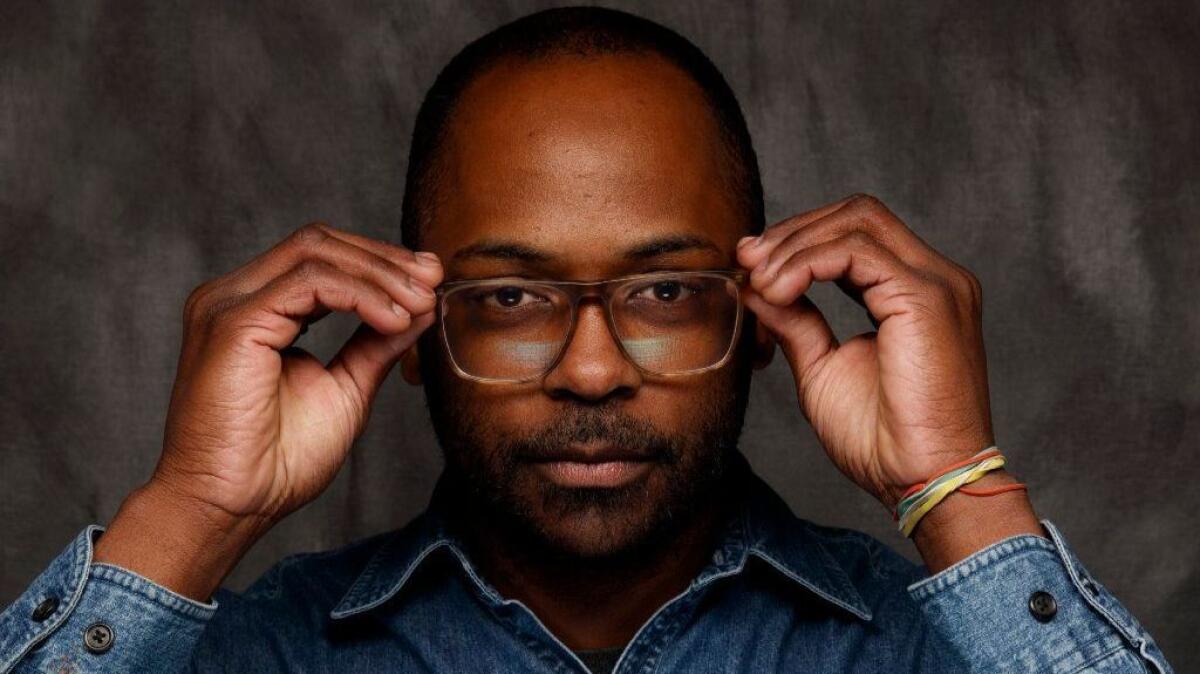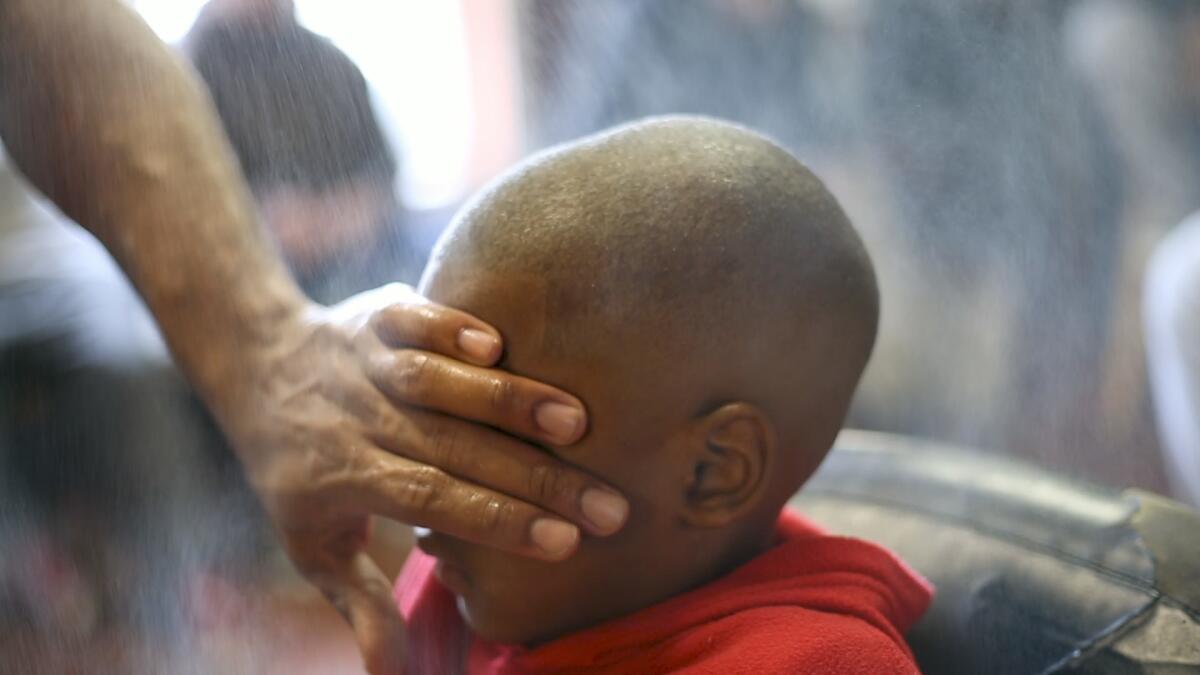Q&A: RaMell Ross is seeking ‘visual justice’ for ‘Hale County’

- Share via
For many black artists — musicians, filmmakers, painters, writers, etc. — art is often burdened with the responsibility of humanizing our communities. There’s been a historical obligation to prove to the world that black folks hurt and love and laugh and live just like their white counterparts, like humans.
Director RaMell Ross rejects this notion.
“I don’t think that people think that [other] people aren’t human. I think they think they’re inferior,” he said, “and inferiority is just as dangerous as a person saying [another] person is not human. So for me, it’s more about connecting people to know that the similarities [between us] are rooted in something that is larger and ‘they’ are not inferior.”
My goal is to create an experience of the historic South, the experience of the centrality of the black experience.
— RaMell Ross
This is one of the objectives of Ross’ Sundance documentary, “Hale County This Morning, This Evening,” which takes a look at the Alabama Black Belt county home to just under 15,000 people, almost 60% of whom are black, according to the U.S. Census.
The film — unique in its aesthetic and innovative in its structure and narrative arc — follows Daniel and Quincy, two young black men, and their families. Ross, who first discovered his subjects while he was the manager of a local youth program and basketball coach, weaves contemporary lived experiences of what the South looks like along with historical context for an intimate portrait of black identity.
FULL COVERAGE: Sundance Film Festival 2018 »
Void of the traditional struggle on which documentaries about the black experience often center, “Hale County” ruptures conventional — and often stereotypical — depictions of black people to create an experience that is simple, complex and revelatory.
While at Sundance, The Times sat down with Ross, a photography professor at Brown University who was one of Filmmaker Magazine’s 25 New Faces of Independent Film in 2015, to discuss his feature documentary debut, which is seeking distribution out of the festival.
What about this subject and this space told you this should be a film and not a photography project?
It was just a feeling that there was more agency, or that there was more purchase, on the human condition or the human mind through moving images. The cinema is incredibly macaronic and incredibly deep. The moving potential is beyond what we really even understand because it’s working on such a deep part of the person. I just felt that there was a lot of space there for imaging in the South. I haven’t seen a current film about the contemporary state of the South as it relates to the history. So I was like, “I think I’m going to give it a try.”
I found the film unusual and eclectic in structure. How would you describe your approach to filmmaking?
I think my approach to filmmaking is burgeoning. The ideas from this film, the idea of the form of this film, is born from a sort of failure, in my opinion, for traditional documentaries to speak to the vastness of the black experience as it relates to [the idea] that we’re made of stars. The gestures of interaction that get lost in the narrative or imagery that is intended to push forth some story can’t just be the image of the person in the moment. The struggle narrative really got to me — most of the stories about blackness, because of the past, obviously, have a very specific poverty struggle, beginning and end, and that forecloses greater understanding of just general humanity.

One of the core ideas of the film is if you don’t show a person’s decisions, then you can’t judge their decisions. So in all the films, a person goes into the store, someone says something to them and the person snaps back to them. Then the person’s like, “He shouldn’t have said anything. He should’ve just kept going.” Therefore, you’re projecting the way you would be in the world or your global view on the film on that. You fail to see that the situation the person is put in is not the decision they’re making. It’s the bigger structure that is contributing to the way they’re responding to this moment.
By fractioning Daniel and Quincy’s narratives, concentrating only on the beautiful, spontaneous moments, you don’t have a chance to judge them — aside from the way in which you would judge a black person because they’re black. Therefore, the way you respond to the film is you, it’s not the film.
The way I’ve been describing it to people is that the film is just showing black Southern folk existing — no obvious plot or narrative arc, though it is complexly layered.
There [are] a lot of intentional things that bring forth different ways that you can speak about the film. One core thing that I wanted to do was elevate Daniel and Quincy’s life to a space of awe, to elevate the Southern experience into a place of ephemeral beauty, to sort of remove it from the constraints of its past — but then let you know that it was born in that, but it’s not only that.
I’m really easily moved, and I really believe, philosophically, that everything in the world exists at every point in time, in every gesture, in every look, in every tick or in every car going by. Structured in the right way, you can bring out the beauty and the metaphor and create meaning. It takes a lot of time to be able to pull those things out. And that’s another thing: People don’t spend enough time with black subjects because of the economy system of media — to make those things visible and, therefore, change the way that people see those things.
Is there a message you want people to take away from the film?
No, [there is] 100% not a message. My whole thing is [about] experience. Knowledge is experience. … My goal is to create an experience of the historic South, the experience of the centrality of the black experience, the experience of Quincy and Daniel’s lives. Let that experience meet [the audience] where they are in their life and then hopefully change the trajectory of the way that they experience black people in the future. That’s something that happens internally. It’s something that happens cerebrally, and it’s not something that is Anglocentric.
Who or what inspires you?
Like I said, I’m really moved by everything. I can look at a person in the world and get tons of experience. But there are a couple of people’s work whose form has really been inspiring. One was Allen Ginsberg’s [poem] “Howl.” It’s robust and descriptive and just blossoming. I really love Godfrey Reggio’s “Qatsi” [film] trilogy. One thing he said in an interview was, and I’m paraphrasing, that language can no longer speak to the complication of the human being in society and capitalism. It’s just too big. The only way we can do that is through images. I was like, that’s kind of true. Images hold so much more than language; [they’re] so much more visceral.
Also, “Killer of Sheep” by Charles Burnett. When that film came out during that time and the way it allowed someone to look at a community ... it is monotonous, no profoundness. That is really effective. It changes people’s understanding of things.
When you found out that you got accepted to Sundance, what was your reaction? Did you ever think it was possible?
No, ’cause when I started to film, I didn’t intend for it to be this big. I knew that it was very conceptual and abstract. I had no intention, [but] a turning point in the film for me was when I met Joslyn Barnes, who works with Danny Glover at Louverture Films. I really connected with her. She understood everything that I was saying, and beyond. Then I met Robb Moss, the chair of the environmental and visual arts department at Harvard, and Maya Krinsky, who’s a critic.
I edited the film, but that was the editing team, and that was where the film really became accessible. It really became fractured, but also where a person could engage with it. Before they came and we had conversations, I was dead set on it being way more of a Rorschach test of the black experience.
I was hoping that it would get in [to Sundance] because I felt that if I could get this film into this platform, then I can talk about a way to visualize the African American experience that can actually provide a break from the traditional way of visualizing and therefore provide some visual justice to society.
So what’s next for you? Do you want to continue making documentary films? Do you want to go into narrative-based films?
I want to do both. I definitely consider myself, for lack of a better term in [a] category, an artist. So I have some smaller projects I’m going to start and some text-based projects. I have some film ideas that I’m starting to pursue. But I’m not so much interested in doing the same thing with the same voice. I don’t imagine the next film that I make being as reflexive as this film is. I imagine it sort of advancing the way of looking, or even bringing this idea into a form that is even more fluid, and less fractured. I don’t know. I’m definitely not pressed to make a film. I’m not pressed to take photos. I’m kind [of] trying to figure out the best way to articulate things and the best form for each of them.
Only good movies
Get the Indie Focus newsletter, Mark Olsen's weekly guide to the world of cinema.
You may occasionally receive promotional content from the Los Angeles Times.








